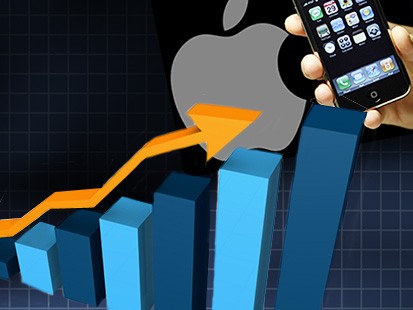 Justin Quinn's rendering of the iPhone 5, based on what has been rumored in the media.
Justin Quinn's rendering of the iPhone 5, based on what has been rumored in the media.The iPhone just does that for people.
We’ve talked here at length on the iPhone 5 News Blog about how the iPhone has come to mean more than just a mobile gadget. Rather, it is an extension of one’s self; something that enhances many aspects of our lives, from finance and shopping, to socialization, information, and even religion (ref: the “confession” app).
It is for that reason that even the many iPhone users out there who don’t work for Apple and help actively craft the form and features of the next iPhone, still have a passion and interest in prognosticating how it will look, feel, and work. Just as a dedicated sports lover lives vicariously through his or her favorite team, so too does the iPhone user want to feel as though he or she is a part of the evolutionary process of the iPhone, given its major role in many of our lives.
Justin Quinn has been one of many “iPhone 5′ers” who have consistently read and commented on the panopoly of iPhone 5 news and rumors over the past nine months or so. During that time, he and many others have debated and discussed what the iPhone 5 will turn out to be. Justin, however, decided to take all that he had read and written, and put it into a series of 3D renderings that bring his — and many of our own — ideas about the iPhone 5 to life.
 Note the 8-megapixel camera and illuminated Apple logo.
Note the 8-megapixel camera and illuminated Apple logo.Taking a look as Justin’s designs, you can quickly see how well he has absorbed the rumors and perspectives that have floated around the iPhone 5 rumor mill. He has appropriated the much-desired 4-inch retina LCD screen, 8-megapixel camera, and a slim profile, maxing out at just .25 inches. He’s also taken a crack at the home button, which has also received a lot of conjecture from iPhone fans, with some calling for the removal of a manual button altogether. Justin removes the circle to capitalize on the inner square of the home button, ostensibly to coincide with the sharp lines of his iPhone 5′s form factor. But the home button’s alterations are not merely aesthetic: both the home button and Apple logo illuminate for notification, and the removal of the circular shape is to save room taken up from the larger screen.
 Justin's renderings capture the ultra-thin profile rumored in the iPhone 5 news.
Justin's renderings capture the ultra-thin profile rumored in the iPhone 5 news.Much has also been made of the construction materials that the iPhone 5 will feature. Justin utilizes virtually every rumored material, from the brushed aluminum on the sides and back, as well as the use of Gorilla glass on the front of the casing.
But what perhaps is most impressive about Mr. Quinn’s renderings of the iPhone 5 is that they aren’t far-fetched. Rather than designing an iPhone 5 design that is more fantasy than reality, Justin leveraged all of the reports, rumors, comments, and perspectives levied over the past months to create a composite iPhone 5 that, while in the end may not end up to be the same design that Steve Jobs signs off on, truly captures the desires of iPhone users. to best of Justin’s impressive talents and gifts, he’s given us a glimpse of what we’ve all wished for.
Many thanks, JustinQ!
Here are some more photos of Justin’s renderings of his vision for the iPhone 5:










 A "mystery man" sent this photo to the iPhone 5 News Blog, claiming it to be an early 4G iPhone 5 prototype.
A "mystery man" sent this photo to the iPhone 5 News Blog, claiming it to be an early 4G iPhone 5 prototype. Compared to the new pre-released iPhone 5 cases, iPhone 4 cases like this one are much more refined
Compared to the new pre-released iPhone 5 cases, iPhone 4 cases like this one are much more refined More photos of purported iPhone 5 cases are surfacing today, begging the question of whether or not Chinese staffers at Apple’s components facilities are leaking tech specs. But while some of these cases may be mere fabrications, others might actually be rolling the dice.
More photos of purported iPhone 5 cases are surfacing today, begging the question of whether or not Chinese staffers at Apple’s components facilities are leaking tech specs. But while some of these cases may be mere fabrications, others might actually be rolling the dice.
 The sleazebags who fuel the iPhone 5 rumor will stop at nothing to create news out of thin air. The so-called “confirmed” sightings of two iPhone devices being manufactured in China confirm only one thing: some people have no shame.
The sleazebags who fuel the iPhone 5 rumor will stop at nothing to create news out of thin air. The so-called “confirmed” sightings of two iPhone devices being manufactured in China confirm only one thing: some people have no shame.





